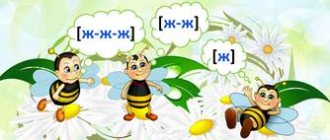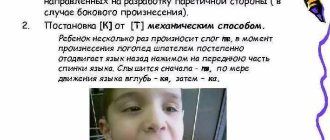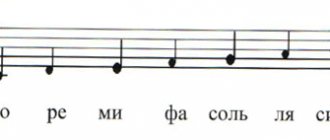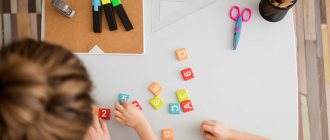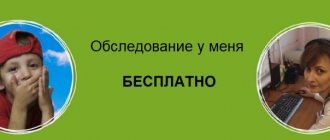Articulation of the sound G
The articulation of the sound [G] is the same as that of the sound [K], only with the participation of the voice. The lips are neutral and take the position of the next vowel. The teeth are open. The tip of the tongue is lowered and touches the lower incisors. The lateral edges of the tongue are pressed against the upper back teeth. The back of the tongue forms a bridge with the palate. The soft palate rises and closes the passage into the nasal cavity. The vocal folds are open. The exhaled stream explodes the bridge between the tongue and the palate, resulting in a characteristic sound. The vocal folds close and vibrate.
Automation of the G sound in syllables
In this exercise, the child is asked to listen, remember and pronounce various syllables and their sequential combinations. The transition from simple to complex is observed.
Combination of G with vowel sounds:
- ha-ha;
- ho-ho;
- goo-goo;
- ga-go-gu;
- uh-huh-uh-huh.
Syllables involving other consonants:
- gwa-gwo-gwu;
- gla-glo-gloo;
- sga-sgo-sgu;
- rga-rgo-rgu.
For G' (soft sound):
- ge-ge;
- gi-gi;
- gli-gli-gli;
- gree-gree-grie.
Automation of the sound [G] at the beginning of words with merging consonants
Repeat the words clearly, emphasizing the sound [g] in your voice.
drive bend anger bend nest
rook pear loud mane mushrooms
nails wilderness clay gloss glaze
depth eye gladiolus edge thunder penny load mushroom
make-up vulture gram milk mushroom primer
pear letter engraver rodent comb
We ALWAYS explain all words that a child does not understand!!!
Consolidating the sound G in a child’s speech
Most speech therapists and speech pathologists consider the concepts of “consolidation” and “automation” as identical.
Sometimes sound consolidation is understood as the step-by-step work process of comprehensive development of a phonetic unit, and automation is the achieved complex result.
The bottom line is that consolidation (automation) means going through a sequential set of various speech exercises that help the child reliably learn a relatively fragile spoken sound.
Each new phonetic image or ideomotor (articulatory) template is especially fragile if the clarification and production of the correct sound was preceded by getting rid of its defective version.
An important aspect of consolidating a speech sound is the need to “test” its use in various arbitrary phrases and sentences, as is what happens in real speech. Below are examples of such exercises.
Automation of the [G] sound in the middle of words
Repeat the words clearly, emphasizing the sound [g] in your voice.
yaga bliss leg horns snow
blizzard book gang rainbow cart
navaga courage hoe pie shack
transom tramp benefit fire gaff mound wagon corral
cackle shoulder straps nail run around
needle garden land weather conversation
highlands begonia polygon agate luggage revolver tan pugach
brigade delegate Rogatina wealth can absenteeism dragoons lagoon figure
jaguar cast iron joker frog jumping
We ALWAYS explain all words that a child does not understand!!!
Word combinations with the sound g: repeat 2-3 times clearly, emphasizing the sound [g] with your voice.
eggnog rotten pear
mountain ridges huge city
border garrison organist play
bunches of grapes parchment paper
loud voice weather forecast
mountain meadows cast iron fence
Exercise “Come up with a word combination based on the pictures.” For example: Talking parrot dirty boots
Words containing two r sounds.
Repeat the words clearly, emphasizing the sound [g] in your voice.
eider gangrene gogol verb
loon gangster cackle squiggle
We ALWAYS explain all words that a child does not understand!!!
Sentences with the sounds G and G'
I caught up with him and overtook him. I'll catch up with Oleg in no time.
Goga had been sick with the flu for a long time. Galya was chasing pigeons.
The pigeons flew into the dovecote. I'm running through the meadow.
Galya asked a riddle. Goga has scales.
Hera plays the oboe. There are huge granite mountains in the Urals.
Cucumbers grow in the garden bed. The goose cackles: “Ha-ha-ha!”
Rooks build nests in trees. Watermelons are loaded into the wagons.
Penguins are standing on the shore. The road is covered with pebbles.
The factory whistle is blowing. Goga has weights.
Gena helps a friend. Gena plays the anthem on the oboe.
Dry your feet on the threshold. Geranium leaves evaporate enough moisture.
Eternal glory to the heroes. The flag has a coat of arms.
Because of the blizzard, friends will not come. There are many camps on the banks of the Volga.
Gena and Galya eat oatmeal porridge. Gena asks Gera to play the guitar.
Galya pouted. The children's camp is located near the mountain.
Red flags are hanging in the city. Goga's leg hurts.
Exercise “Come up with sentences based on pictures.” For example: Grisha plays the guitar.
Lesson summary “Sounds Г, Гь and letter Г”
Goals:
Correctional and developmental:
- get acquainted with the sounds Г, Гь. - learn to identify sounds among other sounds, in syllables, from the composition of a word, to differentiate sounds by hardness and softness; -introduce the graphic designation of sounds - the letter G; — improve the skills of sound-syllable analysis: the ability to determine the place of a sound in a word; - promote the development of memory, attention, thinking, visual and tactile perception;
Educational:
— teach children to conjugate verbs; - continue to teach children the correct use of speech; adjectives, coordinating them with nouns in gender, number, case; numerals, coordinating them with nouns in gender, number, case; -continue work on the prevention of dysgraphia; practice selecting antonyms; Educational: - to cultivate organization, friendliness, independence, a critical and conscious attitude to speech; to cultivate children's need for correct speech.
Equipment:
Cut-out pictures with the sound G, album 2 “I am learning to speak and read” pp. 27, 29, mirrors, a picture of a goose, a gosling, lanterns: blue - green, envelopes with elements of the letter G, an object card of Hans.
Progress of the lesson:
1. Org. moment -Open the envelopes, your pictures are cut. -Collect pictures. -Name your pictures, highlighting 1 sound in your voice. (children name pictures) - Tell me what sound is in all these words? (D) Today in class we will get acquainted with the sounds Г – Гь and the letter G. 2.1) Introducing the sounds Г-Гь. -Guess my riddle: He wanders importantly through the meadow, Comes out of the water dry, Wears red shoes, Gives soft featherbeds. Who is this? (goose) -How does a goose cackle? (ha-ha-ga) -Name 1 sound in a syllable: ha? Place mirrors, pronounce the sound G, pay attention to the position of your lips, teeth, where the tip of your tongue is. (lips in a smile, teeth open, the tip of the tongue lies below and moved away from the lower teeth) Say the sound G again and tell me, when pronouncing the sound G, is there an obstacle? -What's stopping you? (a stream of air breaks the barrier between the back of the tongue and the palate) And if an obstacle is encountered, then what is the sound G? -Now check whether it’s voiced or unvoiced? (voice turns on) -And in the syllable GA, is the G sound hard or soft? -Tell me about the sound G. -Tell me, what is the name of the baby goose? (gosling) -And the gosling cackles: GYA-GYA-GYA -How the gosling cackles: GYA -Name 1 sound in the syllable GYA? Гь -Tell me about the sound Гь.
2. Exercise in pronunciation of sounds Г-Гь.
Open the bookmark books, look in the upper left corner you have a picture of a goose and a gosling. The goose cackles: GA-GA-GA And the little gosling: GYA-GYA-GYA (children build geese with their fingers and make sounds) And in the upper right corner: Yupik He raised his hands up and showed us 2 chips. -Why did Yupik raise 2 chips? Now we will go on a journey. And you have to guess who will travel with us, I will name the word by sounds, and you have to say who it is: G, A, N, S.
3. Sound selection.
A) We catch the sound: among other sounds: O, K, G, B, M, Sh, …. B) among the syllables: GA, DA, TO, DO, GO, GU, LY, AG, ASH, AM, OG, OK, OB C) Look at the picture in the textbook “Hans is getting ready to go on the road” - Name the words with the sound G. -Name words with the sound Гь.
4. Introduction of the plot into the lesson.
The dwarf brought gifts to Hans - pies, jam in a jar. Hans accepted the treat, but didn’t say thank you. -For this, the dwarf turned Hans into a tiny boy and said: “If you go through all the tests, you will become big again.” Fizminutka. At first I’ll be small, I’ll snuggle up to my knees. Then I’ll grow big, I’ll reach the lamp. That’s what I am: Small, big!
5. Hans walks through the meadow and pronounces sentences. Let us help Hans finish his sentences.
I'm walking in the meadow. You…… You….. We…. He…. She….. They….
6. Differentiation of sounds Г-Гь
And you and I will shine lanterns for Hans on the road. Game “Light a Flashlight” If you hear the sound G in a word, pick up a blue flashlight, and if Гь, pick up a green one. GEESE, GENA, STEPS, LEGS, GARAGE, WEIGHT, HERO, GNOME, MEADOWS, ROOK, PEAS, GUITAR. (explain what sound, place of sound in a word) Well done, we helped Hans pass 1 test.
7. Game “On the contrary”
And here is the task for you - test 2: Say the words in reverse: In them, put G forward: Quiet - loud, clean - ..., cheerful -..., smart -...., well-fed -.... rare -…. small -..., rough -... Well done, we helped Hans pass the 2nd test.
8. Sound-syllable analysis of words.
Hans is sailing on a ship. Suddenly there is a storm at sea. Hans exclaimed: “There will be trouble! Am I really going to drown? -We need to save Hans. Captain Vrungel's yacht sails past the sinking ship. Captain Vrungel throws life preservers to Hans. Hans will catch the circles when word patterns are made: Hans, geese. Well done, we helped Hans again.
9. Introducing the letters G g.
-Remind me what sounds we are talking about today? -Tell me about the sound Г, Гь. The sounds Г, Гь are indicated by the letter Г. Look at the letter in the blue frame. -What does the letter look like? -Look at the goose in the upper left corner of the page. She stretched her neck, depicting the letter G. So you use your hand to show the letter G. Count how many letters G are drawn in the textbook? Take the envelopes and build the letter G from the elements. Now trace the letter with your finger and write it. Well done, we completed one more test: we built letters.
10. Formation of the plural of nouns.
And the last test. Game “One - Many” Cucumber - cucumbers, dove - ......., berry - ....., meadow - ......, store - ....., city - ....., garage - ....., goose - ...... guest -……, thunderstorm -……, mountain -……, newspaper -…..parrot -…..
11. Count objects, clearly pronouncing the sound G.
One dove, 2..., 5, One button, 2.5, One nest, 2.5. Well done guys, we completed all the tests.
12. Summary of the lesson.
The dwarf cast a spell on Hans and gave him his former height. Hans returned home. He is not small - he is big! - What sounds did we meet today? -Tell me about the sound Г, Гь. -Which letter represents the sounds Г,Гь? -Come up with words with the sounds Г,Гь.
Author of the material: Minina Natalia Nikolaevna
Also on topic:
Summary of speech therapy lesson topic: Sounds M - M. Winter
Automation of the G sound in pure tongues
Pure sayings are easy-to-remember comic similarities to nursery rhymes or counting rhymes that are well suited for the role of exercises. Pure tongues begin with the repetition of several syllables, where attention is focused on the sound being reinforced.
Composing phrases yourself is a good way for parents to creatively approach the development of their child’s speech. It's better if they make at least a little sense. Here are some examples.
- Ha-ha-ga, ha-ha-ha, - the geese go to the meadows.
- Oh-ho-ho, oh-ho-ho! - There is nothing in the cave.
- Goo-goo-goo, goo-goo-goo, - the owl is hiding in a haystack.
- E-ge-ge, e-ge-ge! - we are running along the rainbow.
- Gi-gi-gi, gi-gi-gi, they call us for pies.
Conclusion
The G sound is far from the only one that causes difficulties for young children. When working with a child, we must remember that an adult’s speech must be clearly intonated, and the external features of articulation must be clearly distinguishable.
You should not repeat defective scale patterns after your child. It is useful to show examples of correct speech several times. It is recommended to stimulate the child’s speech with questions.
